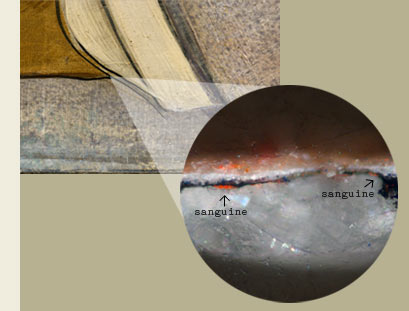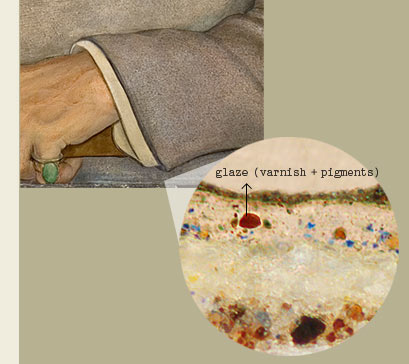

CROSS SECTION 1
Cross section of the microsample taken from the lower part of the left sleeve showing a thin layer of red earth pigment. This fine line appears beneath the black layer of the underdrawing (carbon black). Taken with Mplan objective lens (20X/0.40).
Cross section of the microsample taken from the lower part of the left sleeve showing a thin layer of red earth pigment. This fine line appears beneath the black layer of the underdrawing (carbon black). Taken with Mplan objective lens (20X/0.40).

CROSS SECTION 2
The microsample taken from the curtain shows that the grisaille coat in this area of the painting is thick, and consists of a mixture of linseed oil, turpentine and mastic resin, as identified in the adjoining chromatogram. Observation under UV light (Mplan objective lens 50X/0.75).
The microsample taken from the curtain shows that the grisaille coat in this area of the painting is thick, and consists of a mixture of linseed oil, turpentine and mastic resin, as identified in the adjoining chromatogram. Observation under UV light (Mplan objective lens 50X/0.75).

CROSS SECTION 3
The microsample taken from the tie shows successive thin layers containing tempera grassa (staining red to acid fuchsine in the laboratory) alternating with brushstrokes using linseed oil and/or mastic resin (distinguishable as thin layers that do not stain to a specific protein-selective dye). This stratigraphic section illustrates the complex layering used by Dix in this painting. Taken with Mplan objective lens (20X/0.40).
The microsample taken from the tie shows successive thin layers containing tempera grassa (staining red to acid fuchsine in the laboratory) alternating with brushstrokes using linseed oil and/or mastic resin (distinguishable as thin layers that do not stain to a specific protein-selective dye). This stratigraphic section illustrates the complex layering used by Dix in this painting. Taken with Mplan objective lens (20X/0.40).

CROSS SECTION 4
Cross section of the microsample taken from the background, in an area close to the sleeve, showing layers of impasto covered by transparent glazes containing mastic resin and scattered pigments. Taken with Mplan objective lens (20X/0.40).
Cross section of the microsample taken from the background, in an area close to the sleeve, showing layers of impasto covered by transparent glazes containing mastic resin and scattered pigments. Taken with Mplan objective lens (20X/0.40).















